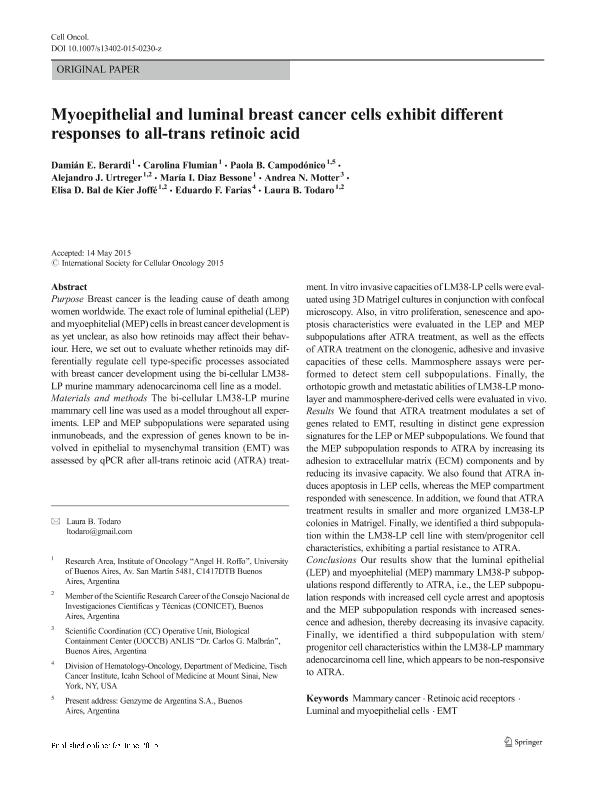Artículo
Myoepithelial and luminal breast cancer cells exhibit different responses to all-trans retinoic acid
Berardi, Damian Emilio ; Flumian, Carolina
; Flumian, Carolina ; Campodónico, Paola Bernadette
; Campodónico, Paola Bernadette ; Urtreger, Alejandro Jorge
; Urtreger, Alejandro Jorge ; Díaz Bessone, María Inés
; Díaz Bessone, María Inés ; Motter, Andrea N.; Bal, Elisa Dora
; Motter, Andrea N.; Bal, Elisa Dora ; Farias, Eduardo F.; Todaro, Laura Beatriz
; Farias, Eduardo F.; Todaro, Laura Beatriz
 ; Flumian, Carolina
; Flumian, Carolina ; Campodónico, Paola Bernadette
; Campodónico, Paola Bernadette ; Urtreger, Alejandro Jorge
; Urtreger, Alejandro Jorge ; Díaz Bessone, María Inés
; Díaz Bessone, María Inés ; Motter, Andrea N.; Bal, Elisa Dora
; Motter, Andrea N.; Bal, Elisa Dora ; Farias, Eduardo F.; Todaro, Laura Beatriz
; Farias, Eduardo F.; Todaro, Laura Beatriz
Fecha de publicación:
08/2015
Editorial:
Kluwer Academic/Plenum Publ
Revista:
Cellular Oncology
ISSN:
2211-3428
e-ISSN:
2211-3436
Idioma:
Inglés
Tipo de recurso:
Artículo publicado
Clasificación temática:
Resumen
Purpose: Breast cancer is the leading cause of death among women worldwide. The exact role of luminal epithelial (LEP) and myoephitelial (MEP) cells in breast cancer development is as yet unclear, as also how retinoids may affect their behaviour. Here, we set out to evaluate whether retinoids may differentially regulate cell type-specific processes associated with breast cancer development using the bi-cellular LM38-LP murine mammary adenocarcinoma cell line as a model. Materials and methods: The bi-cellular LM38-LP murine mammary cell line was used as a model throughout all experiments. LEP and MEP subpopulations were separated using inmunobeads, and the expression of genes known to be involved in epithelial to mysenchymal transition (EMT) was assessed by qPCR after all-trans retinoic acid (ATRA) treatment. In vitro invasive capacities of LM38-LP cells were evaluated using 3D Matrigel cultures in conjunction with confocal microscopy. Also, in vitro proliferation, senescence and apoptosis characteristics were evaluated in the LEP and MEP subpopulations after ATRA treatment, as well as the effects of ATRA treatment on the clonogenic, adhesive and invasive capacities of these cells. Mammosphere assays were performed to detect stem cell subpopulations. Finally, the orthotopic growth and metastatic abilities of LM38-LP monolayer and mammosphere-derived cells were evaluated in vivo. Results: We found that ATRA treatment modulates a set of genes related to EMT, resulting in distinct gene expression signatures for the LEP or MEP subpopulations. We found that the MEP subpopulation responds to ATRA by increasing its adhesion to extracellular matrix (ECM) components and by reducing its invasive capacity. We also found that ATRA induces apoptosis in LEP cells, whereas the MEP compartment responded with senescence. In addition, we found that ATRA treatment results in smaller and more organized LM38-LP colonies in Matrigel. Finally, we identified a third subpopulation within the LM38-LP cell line with stem/progenitor cell characteristics, exhibiting a partial resistance to ATRA. Conclusions: Our results show that the luminal epithelial (LEP) and myoephitelial (MEP) mammary LM38-P subpopulations respond differently to ATRA, i.e., the LEP subpopulation responds with increased cell cycle arrest and apoptosis and the MEP subpopulation responds with increased senescence and adhesion, thereby decreasing its invasive capacity. Finally, we identified a third subpopulation with stem/progenitor cell characteristics within the LM38-LP mammary adenocarcinoma cell line, which appears to be non-responsive to ATRA.
Archivos asociados
Licencia
Identificadores
Colecciones
Articulos(OCA HOUSSAY)
Articulos de OFICINA DE COORDINACION ADMINISTRATIVA HOUSSAY
Articulos de OFICINA DE COORDINACION ADMINISTRATIVA HOUSSAY
Citación
Berardi, Damian Emilio; Flumian, Carolina; Campodónico, Paola Bernadette; Urtreger, Alejandro Jorge; Díaz Bessone, María Inés; et al.; Myoepithelial and luminal breast cancer cells exhibit different responses to all-trans retinoic acid; Kluwer Academic/Plenum Publ; Cellular Oncology; 38; 4; 8-2015; 289-305
Compartir
Altmétricas



